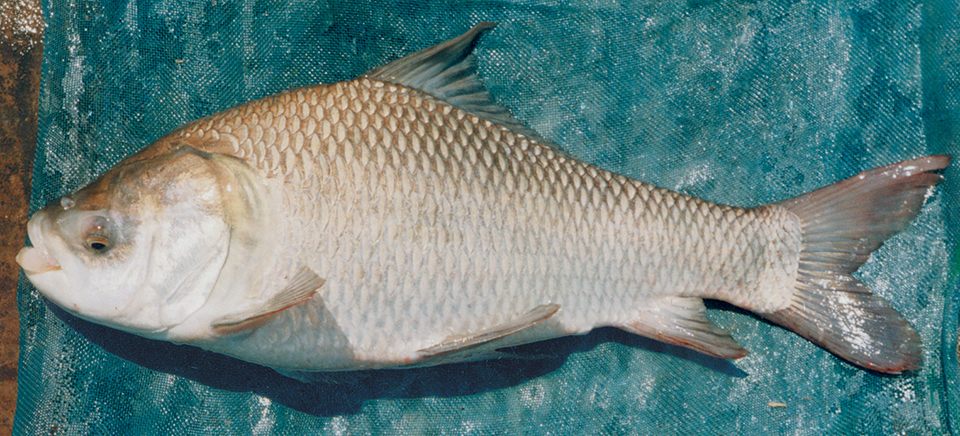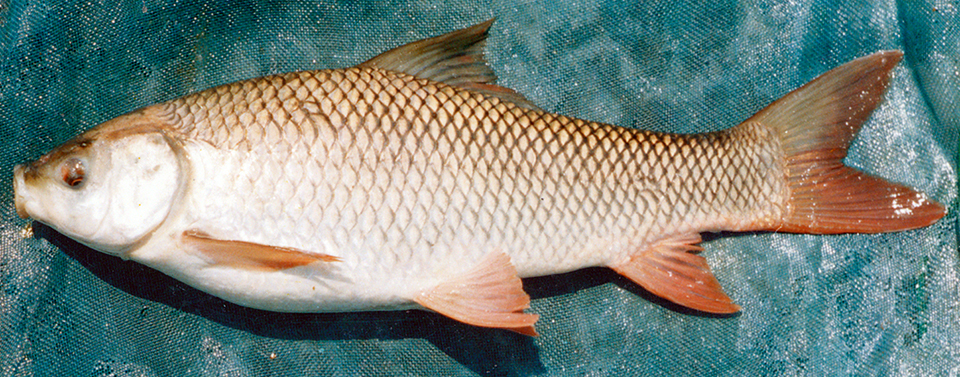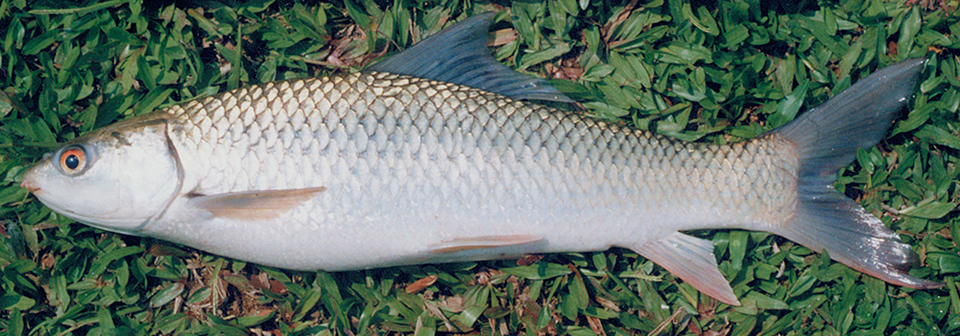Indigenous species fuel India as leading aquaculture producer
India is the second-largest producer of farmed fish in the world, and carp contribute most of the country’s aquaculture production. Three major species of carp indigenous to the rivers of the Indian subcontinent – Catla catla (common name: Catla), Labeo rohita (Rohu), and Cirrhinus mrigala (Mrigal) – are widely cultivated in India and parts of Southeast Asia. Current annual production of these species is about 2 million MT.
Historic culture
The oldest record of aquaculture in India dates back to 300 B.C. Carp have been farmed in the Bengal region for many centuries.
Modern carp culture started in the 1950s and 1960s, when large tanks and reservoirs were built for irrigation and hydroelectricity generation. Induced reproduction accomplished during this time led to large-scale breeding of carp throughout India to stock existing ponds, tanks, and reservoirs. Widespread commercial culture started in the 1980s.
Aquaplosion
The southern state of Andhra Pradesh led the dramatic development known as “Aquaplosion” or “Blue Revolution” in the country. Vast areas of paddy fields were converted into fish ponds, since culture of Indian major carp was more profitable than traditional paddy cultivation.
Currently, the state has 80,000 ha devoted to carp culture, with 80 percent of this area in the vicinity of Kolleru Lake, a large freshwater impoundment. Polyculture of carp in fertilized ponds with only supplementary feeding results in annual yields of 5 to 13 metric tons (MT) per hectare.
Carp culture has recently expanded rapidly in the northwestern states of Punjab and Haryana. It has also been successfully adapted in the neighboring state of Karnataka, particularly in the districts of Raichur and Bellary, which adjoin Andhra Pradesh.
Polyculture of Indian major carp
The three Indian major carps are suitable for farming because they adapt very well to commercial culture conditions, grow fast to a large size (1-2 kg) within one or two years, and have desirable eating qualities. More importantly, they have feeding niches with little overlap, making them highly suitable for polyculture.
Catla
The Catla is a planktivorous fish that feeds predominantly on zooplankton in nature. It lives in the upper layers of the water column and is known as a surface feeder. This species has a big head and deep body when compared to other Indian carp (Fig. 1).

Rohu
The Rohu is a column feeder that feeds on both phytoplankton and zooplankton. It grows rapidly and reaches over 1 kg in a year. Its head is smaller than that of Catla, with a terminal mouth and fringed lips. The body is longer than Catla (Fig. 2) and slightly pinkish.

Mrigal
The Mrigal is a bottom feeder that feeds on detritus and plankton. Its head is smaller and body longer than in Catla for a similar size fish. It can be easily distinguished from the Rohu because of its subterminal mouth with nonfringed lips. Its body color is generally white with pinkish fins (Fig. 3).

Natural food
The larval stages of all carp feed on zooplankton. Carp readily accept formulated pelleted feeds and can be cultured entirely on dry feeds formulated with mainly plant ingredients. However, in commercial pond culture, natural food forms a major part of their diet.
Other species
Common carp, the major Chinese carps (silver and grass carp), and some smaller Indian carp species can be stocked in polyculture along with the three Indian major carps.
Silver carp (Hypophthalmichthys molitrix) feed primarily on phytoplankton, while grass carp eat aquatic and terrestrial vegetation, so they naturally complement the feeding niches of the Indian carp. Silver carp grow fast and reach as much as 2 kg in a year in warmer Indian waters. But their use in commercial farms is on the decline because their flesh deteriorates rapidly after harvest. Also, because of their taste and many intermuscular bones, silver carp are not relished by the Indian people.
Grass carp (Ctenopharyngodon idella) grow very fast when sufficient macrovegetation is available as food. Growth slows when these fish are offered only supplementary feed. They may be used at low densities in commercial culture to manage weeds. Grass carp are mainly employed in perennial reservoirs, tanks, and ponds that are usually infested with aquatic weeds.
Common carp
The common carp (Cyprinus carpio) has been cultured in polyculture with Indian major carp, but is also used in monoculture, particularly by small and artisan farmers. Monoculture of common carp is widely practiced in seasonal tanks in the Kolar and Tumkur districts of Karnataka.
The species is an omnivorous feeder that feeds on detritus, other wastes, and aquatic vegetation in nature. It readily accepts pelleted feeds and grows to market size within a year.
One advantage of common carp is its year-round availability of seed – unlike Indian major carp, whose seedstock is available only during the June-September monsoon season. Techniques to produce all-male common carp through hormonal manipulation have been developed by the University of Agricultural Sciences, Bangalore.
A disadvantage of common carp is they mature early and start uncontrolled spawning within six months. Another disadvantage is their burrowing nature, which results in the need for periodic repairs of pond bottoms and levees.
Grow-out technology
Although 1-ha ponds are ideal for management of carp production, farmers build ponds depending upon the size of their operations and availability of land. In many farms, the typical ponds average 0.4 ha or less.
Pond preparation starts with the manual or mechanical eradication of all unwanted weeds. Undesirable and predatory fishes are also eliminated using applications of bleaching powder or mahua oil cake, which contains saponin that destroys red blood cells in fish. Aquatic insects are killed by applying soap oil emulsion or insecticides. Liming at 400 to 500 kilograms per hectare and fertilization with cattle dung or the preferred poultry droppings at 4,000-5,000 kilograms manure per hectare typically follow.
Stocking
The ideal stocking density for carp fingerlings in grow-out ponds is 10,000 per hectare. The ratio of different species is important in polyculture operations.
The general recommendation is to use 4:2:3:1 ratios of surface feeders, columnar feeders, bottom feeders, and macrophyte feeders, respectively. Since silver carp, grass carp, and Mrigal are not currently favored in Indian polyculture systems, stockings usually include Catla and Rohu, or Catla, Rohu, and common carp. It is fairly common to stock 1,000 each of Catla, Rohu, and common carp in a 0.4-ha pond.
Typical yields in these systems are 5 to 13 MT per hectare per year, but could be as high as 17 MT per hectare per year under improved management conditions.
Technology development
While research conducted by various Indian organizations has played a key role in the development of polyculture systems for Indian major carp, farmers also contributed significantly to the development of new technology.
One of the notable innovations by farmers in Andhra Pradesh has been to stunt fingerlings in the first year and use them in grow-out in the subsequent year. Carp spawn during the monsoon months and fingerlings are typically ready for stocking as the winter season starts. The fingerlings overwinter in ponds at densities over 10 animals per square meter with maintenance feeding. When they are restocked at lower densities in grow-out ponds the subsequent year, they exhibit remarkable compensatory growth and grow to market size within a year.
The market size for carp in India is around 1 kg, which is normally reached in 10 to 12 months of culture, but smaller fish are acceptable to small families. Observations indicate that growth and survival of the stunted and restocked fingerlings are significantly superior to that of directly stocked fingerlings.
Constraints
The major constraint to further development of carp culture in India is that at present supply and demand levels, fish farmers do not get adequate market prices for their product. The prevailing average price in southern India at farm gate is Rs. 23 to 25 per kilogram (U.S. $0.45 to 0.50). The cost of production is about Rs. 15 to 18 per kilogram ($0.30 to 0.36).
The highest demand for carps is in the eastern part of the country, particularly in the city of Calcutta. However, this requires transport of iced fish over a long distance. For carp culture to expand, local demand must increase and/or production costs must decrease considerably.
Production-related constraints include insufficient seedstock availability throughout the year, a high incidence of disease, and limited freshwater resources. Because carp grow fairly well in brackish estuarine ponds and shrimp ponds abandoned due to White Spot Syndrome Virus, their culture in these areas could be an interesting possibility.
(Editor’s Note: This article was originally published in the August 2002 print edition of the Global Aquaculture Advocate.)
Now that you've finished reading the article ...
… we hope you’ll consider supporting our mission to document the evolution of the global aquaculture industry and share our vast network of contributors’ expansive knowledge every week.
By becoming a Global Seafood Alliance member, you’re ensuring that all of the pre-competitive work we do through member benefits, resources and events can continue. Individual membership costs just $50 a year. GSA individual and corporate members receive complimentary access to a series of GOAL virtual events beginning in April. Join now.
Not a GSA member? Join us.
Author
-
H. Shivananda Murthy, Ph.D.
Associate Professor of Aquaculture
University of Agricultural Sciences
College of Fisheries
Mangalore 575 002 India
Tagged With
Related Posts

Aquafeeds
A look at India’s fish feed industry
India's fish-farming industry makes limited use of modern feeds, providing potential for the feed sector to grow. Commercial feeds are predominantly used for pangasius farming, followed by a rising popularity in carp culture.

Innovation & Investment
Aquaculture Innovation Challenge taps startup spirit to lift Indonesia’s shrimp sector
The Aquaculture Innovation Challenge, a contest organized by Netherlands-based Seafood Trade Intelligence Portal, sought to give Indonesia’s struggling shrimp sector a boost.

Responsibility
Bangladesh study examines potential for prawn cage farming
While Bangladesh's prawn industry is based on pond culture, a feasibility study was conducted to establish prawn cage culture to benefit resource-poor fishers and landless people.

Intelligence
Can India sustain its farmed shrimp boom?
Long a global leader in farmed fish production, India has transitioned into an aquaculture powerhouse. Can its expanding shrimp sector keep the rapid pace?


